Analysis of Remote Healthcare Monitoring System: Research Report
VerifiedAdded on 2020/05/01
|35
|9851
|37
Report
AI Summary
This research report provides a detailed analysis of remote healthcare monitoring systems. It begins with an introduction to the concept and its significance in improving healthcare, particularly for patients with chronic conditions. The report explores various aspects, including remote monitoring technologies, methods for managing chronic conditions, and the components of telemonitoring systems. It examines data transmission methods, data integration, and the challenges associated with implementing remote healthcare monitoring. Furthermore, the report delves into the conceptual framework, basic design functionalities, factors influencing, opportunities, and challenges of remote healthcare monitoring systems. It also discusses the impact of these systems on patients and healthcare professionals, explores their applications, and considers future research directions. The report emphasizes the importance and scope of remote healthcare monitoring, highlighting its potential to enhance healthcare delivery and patient outcomes.
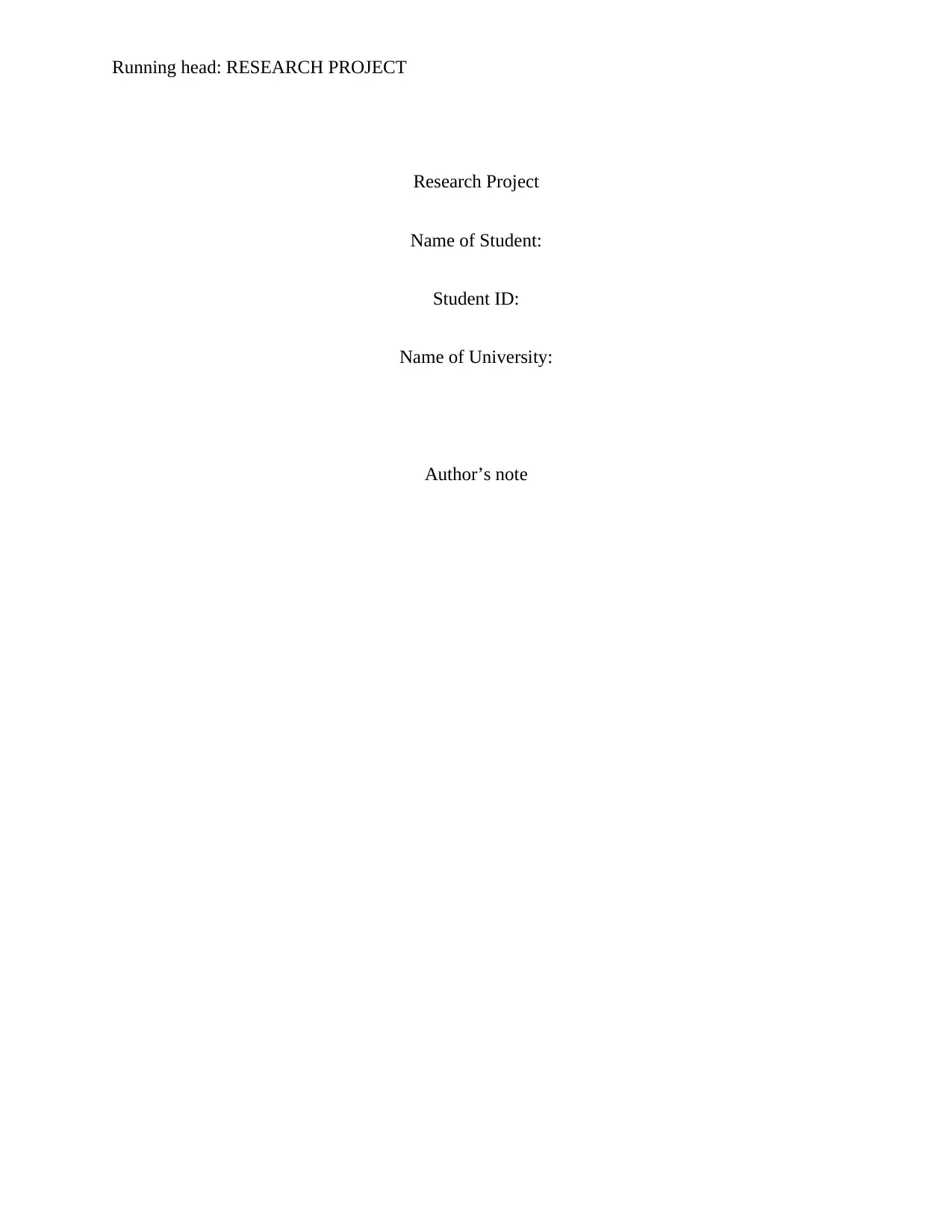
Running head: RESEARCH PROJECT
Research Project
Name of Student:
Student ID:
Name of University:
Author’s note
Research Project
Name of Student:
Student ID:
Name of University:
Author’s note
Paraphrase This Document
Need a fresh take? Get an instant paraphrase of this document with our AI Paraphraser
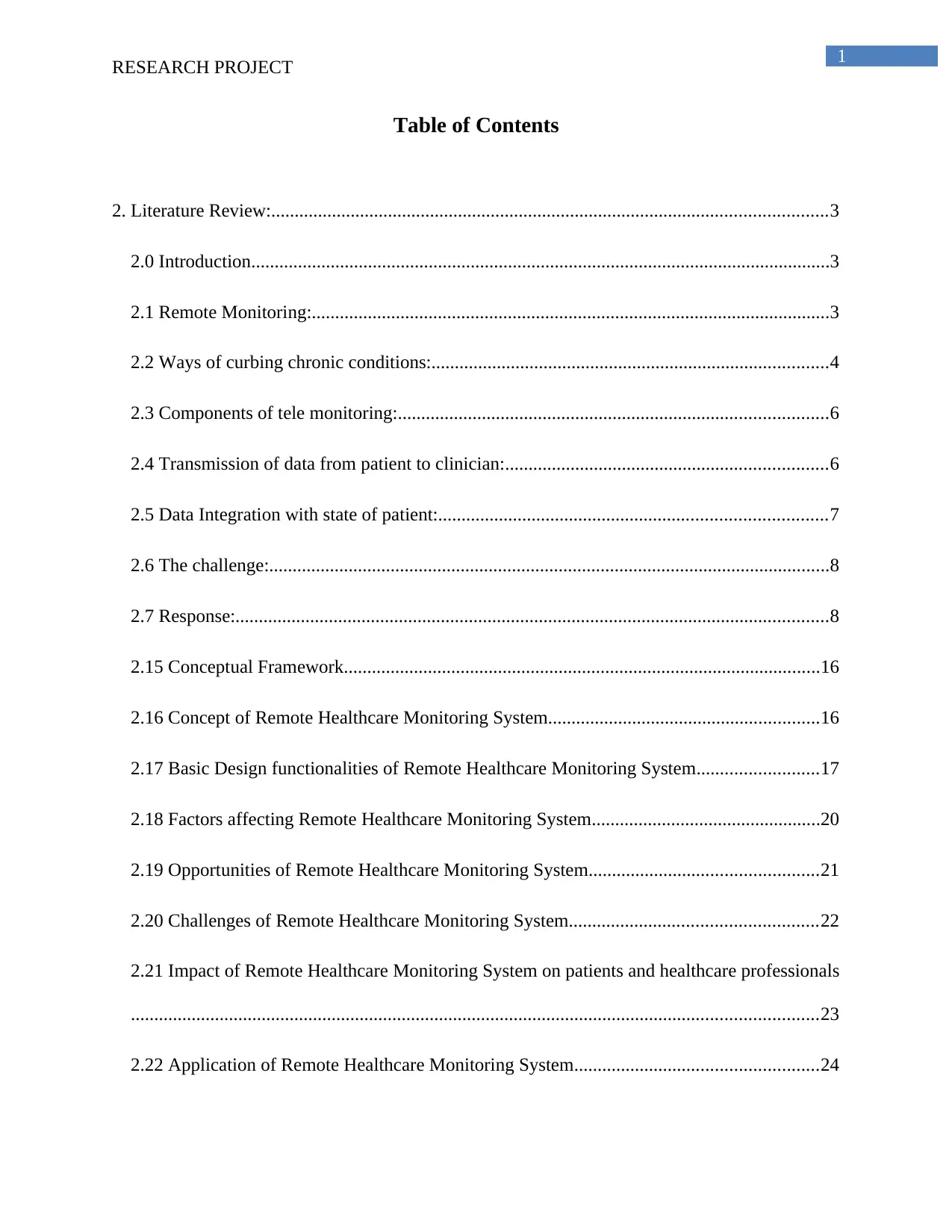
1
RESEARCH PROJECT
Table of Contents
2. Literature Review:.......................................................................................................................3
2.0 Introduction............................................................................................................................3
2.1 Remote Monitoring:...............................................................................................................3
2.2 Ways of curbing chronic conditions:.....................................................................................4
2.3 Components of tele monitoring:............................................................................................6
2.4 Transmission of data from patient to clinician:.....................................................................6
2.5 Data Integration with state of patient:...................................................................................7
2.6 The challenge:........................................................................................................................8
2.7 Response:...............................................................................................................................8
2.15 Conceptual Framework......................................................................................................16
2.16 Concept of Remote Healthcare Monitoring System..........................................................16
2.17 Basic Design functionalities of Remote Healthcare Monitoring System..........................17
2.18 Factors affecting Remote Healthcare Monitoring System.................................................20
2.19 Opportunities of Remote Healthcare Monitoring System.................................................21
2.20 Challenges of Remote Healthcare Monitoring System.....................................................22
2.21 Impact of Remote Healthcare Monitoring System on patients and healthcare professionals
...................................................................................................................................................23
2.22 Application of Remote Healthcare Monitoring System....................................................24
RESEARCH PROJECT
Table of Contents
2. Literature Review:.......................................................................................................................3
2.0 Introduction............................................................................................................................3
2.1 Remote Monitoring:...............................................................................................................3
2.2 Ways of curbing chronic conditions:.....................................................................................4
2.3 Components of tele monitoring:............................................................................................6
2.4 Transmission of data from patient to clinician:.....................................................................6
2.5 Data Integration with state of patient:...................................................................................7
2.6 The challenge:........................................................................................................................8
2.7 Response:...............................................................................................................................8
2.15 Conceptual Framework......................................................................................................16
2.16 Concept of Remote Healthcare Monitoring System..........................................................16
2.17 Basic Design functionalities of Remote Healthcare Monitoring System..........................17
2.18 Factors affecting Remote Healthcare Monitoring System.................................................20
2.19 Opportunities of Remote Healthcare Monitoring System.................................................21
2.20 Challenges of Remote Healthcare Monitoring System.....................................................22
2.21 Impact of Remote Healthcare Monitoring System on patients and healthcare professionals
...................................................................................................................................................23
2.22 Application of Remote Healthcare Monitoring System....................................................24

2
RESEARCH PROJECT
2.23 Future Scope of the Research............................................................................................25
2.24 Importance of remote health care monitoring system:......................................................25
2.25 Scope of remote health care monitoring system:...............................................................26
2.26 Conclusion.........................................................................................................................27
RESEARCH PROJECT
2.23 Future Scope of the Research............................................................................................25
2.24 Importance of remote health care monitoring system:......................................................25
2.25 Scope of remote health care monitoring system:...............................................................26
2.26 Conclusion.........................................................................................................................27
⊘ This is a preview!⊘
Do you want full access?
Subscribe today to unlock all pages.

Trusted by 1+ million students worldwide

3
RESEARCH PROJECT
2. Literature Review:
2.0 Introduction
This chapter helps in developing a deep understanding and knowledge regarding the
significance of remote healthcare monitoring in the healthcare. The chapter highlights the
concept of remote healthcare monitoring along with discussing the basic design of the MHM,
opportunities, challenges and the impact of the patients and the healthcare professionals. The
implementation of RHM has enhanced the healthcare system in Australia.
2.1 Remote Monitoring:
It is important to understand the ways the healthcare professionals can ensure in
delivering invariable and eminence care to the patients staying in the remote locations. It is also
significant in understanding the ways patients ensure they get the support of the professionals
without spending much time along with efforts in visiting the hospital. The answer to all these
questions lies in the fact of patient monitoring system; an action taken up in investigating the
health of the patient without physically being present there, helpful especially for elderly people
or the ones suffering from chronic disease. The incorporation of the technologies of
communication mould into the patient care has offered the professionals with game shifting
resolution in delivering a better quality of medical awareness on remote basis.
Remote monitoring is one of the healthcare sort technologies that facilitates the patients
in using a mobile medical device in performing of a schedule test and sending the data to the
professionals related to healthcare in real-time (Benharref &Serhani, 2014). Remote monitoring
technology takes into consideration the regular monitoring devices like the meters of glucose for
patients having diabetes, heart or blood anxiety monitors for the patients receiving care for
RESEARCH PROJECT
2. Literature Review:
2.0 Introduction
This chapter helps in developing a deep understanding and knowledge regarding the
significance of remote healthcare monitoring in the healthcare. The chapter highlights the
concept of remote healthcare monitoring along with discussing the basic design of the MHM,
opportunities, challenges and the impact of the patients and the healthcare professionals. The
implementation of RHM has enhanced the healthcare system in Australia.
2.1 Remote Monitoring:
It is important to understand the ways the healthcare professionals can ensure in
delivering invariable and eminence care to the patients staying in the remote locations. It is also
significant in understanding the ways patients ensure they get the support of the professionals
without spending much time along with efforts in visiting the hospital. The answer to all these
questions lies in the fact of patient monitoring system; an action taken up in investigating the
health of the patient without physically being present there, helpful especially for elderly people
or the ones suffering from chronic disease. The incorporation of the technologies of
communication mould into the patient care has offered the professionals with game shifting
resolution in delivering a better quality of medical awareness on remote basis.
Remote monitoring is one of the healthcare sort technologies that facilitates the patients
in using a mobile medical device in performing of a schedule test and sending the data to the
professionals related to healthcare in real-time (Benharref &Serhani, 2014). Remote monitoring
technology takes into consideration the regular monitoring devices like the meters of glucose for
patients having diabetes, heart or blood anxiety monitors for the patients receiving care for
Paraphrase This Document
Need a fresh take? Get an instant paraphrase of this document with our AI Paraphraser

4
RESEARCH PROJECT
cardiac treatment. This data can be send to the office of general practice with an internet
connection along with an application for software installed in a computer, tablet or Smartphone
in patient’s home. The information is being stored within a database so the professional of
healthcare can evaluate the data.
2.2 Ways of curbing chronic conditions:
It is only subject to time before the exam-room-centered centers around the care for
patients, giving way to the management of the patients dispensed in maintaining or improving of
the health. However, it would not give away the routine and active treatment of the sick patients
by the physicians. As per Klasnja & Pratt, (2012), new models of payment added with financial
incentives and hindrance for the physicians, call on the providers of healthcare in better
managing the population of patients as a mean of preventing issues related to health and progress
on the outcome.
This business that is emerging and the need for clinical has pretended the expansion of a
technology class that associates patients present status of medical to the physicians along with
other caregivers in the hospitals and practices offering primary care. It is a compilation of the
vital-sign takers, trackers for activity along with other devices in stepping on or strapping on and
then transmitting the readings of the same to a assortment position within a computer or any
secured site within the internet ‘cloud’. At its very best such technologies have the ability in
picking the weight again, prominent hypertension or certain other apprehension before they
develop into threats to life or health.
Remote monitoring is extremely significant and potentially in the vanguard for the
technologies in mobile for its probable significance in lessening the rates of hospital readmission
RESEARCH PROJECT
cardiac treatment. This data can be send to the office of general practice with an internet
connection along with an application for software installed in a computer, tablet or Smartphone
in patient’s home. The information is being stored within a database so the professional of
healthcare can evaluate the data.
2.2 Ways of curbing chronic conditions:
It is only subject to time before the exam-room-centered centers around the care for
patients, giving way to the management of the patients dispensed in maintaining or improving of
the health. However, it would not give away the routine and active treatment of the sick patients
by the physicians. As per Klasnja & Pratt, (2012), new models of payment added with financial
incentives and hindrance for the physicians, call on the providers of healthcare in better
managing the population of patients as a mean of preventing issues related to health and progress
on the outcome.
This business that is emerging and the need for clinical has pretended the expansion of a
technology class that associates patients present status of medical to the physicians along with
other caregivers in the hospitals and practices offering primary care. It is a compilation of the
vital-sign takers, trackers for activity along with other devices in stepping on or strapping on and
then transmitting the readings of the same to a assortment position within a computer or any
secured site within the internet ‘cloud’. At its very best such technologies have the ability in
picking the weight again, prominent hypertension or certain other apprehension before they
develop into threats to life or health.
Remote monitoring is extremely significant and potentially in the vanguard for the
technologies in mobile for its probable significance in lessening the rates of hospital readmission
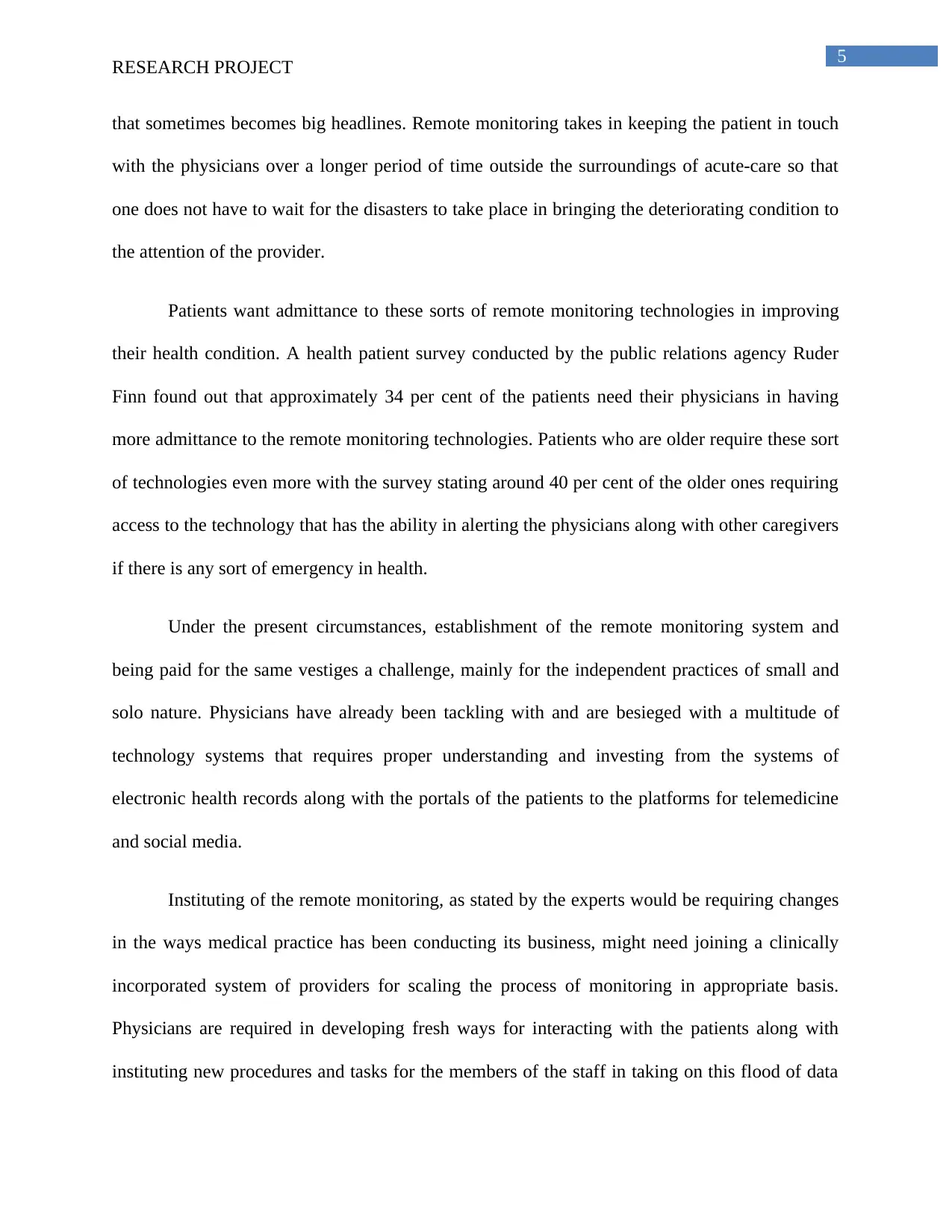
5
RESEARCH PROJECT
that sometimes becomes big headlines. Remote monitoring takes in keeping the patient in touch
with the physicians over a longer period of time outside the surroundings of acute-care so that
one does not have to wait for the disasters to take place in bringing the deteriorating condition to
the attention of the provider.
Patients want admittance to these sorts of remote monitoring technologies in improving
their health condition. A health patient survey conducted by the public relations agency Ruder
Finn found out that approximately 34 per cent of the patients need their physicians in having
more admittance to the remote monitoring technologies. Patients who are older require these sort
of technologies even more with the survey stating around 40 per cent of the older ones requiring
access to the technology that has the ability in alerting the physicians along with other caregivers
if there is any sort of emergency in health.
Under the present circumstances, establishment of the remote monitoring system and
being paid for the same vestiges a challenge, mainly for the independent practices of small and
solo nature. Physicians have already been tackling with and are besieged with a multitude of
technology systems that requires proper understanding and investing from the systems of
electronic health records along with the portals of the patients to the platforms for telemedicine
and social media.
Instituting of the remote monitoring, as stated by the experts would be requiring changes
in the ways medical practice has been conducting its business, might need joining a clinically
incorporated system of providers for scaling the process of monitoring in appropriate basis.
Physicians are required in developing fresh ways for interacting with the patients along with
instituting new procedures and tasks for the members of the staff in taking on this flood of data
RESEARCH PROJECT
that sometimes becomes big headlines. Remote monitoring takes in keeping the patient in touch
with the physicians over a longer period of time outside the surroundings of acute-care so that
one does not have to wait for the disasters to take place in bringing the deteriorating condition to
the attention of the provider.
Patients want admittance to these sorts of remote monitoring technologies in improving
their health condition. A health patient survey conducted by the public relations agency Ruder
Finn found out that approximately 34 per cent of the patients need their physicians in having
more admittance to the remote monitoring technologies. Patients who are older require these sort
of technologies even more with the survey stating around 40 per cent of the older ones requiring
access to the technology that has the ability in alerting the physicians along with other caregivers
if there is any sort of emergency in health.
Under the present circumstances, establishment of the remote monitoring system and
being paid for the same vestiges a challenge, mainly for the independent practices of small and
solo nature. Physicians have already been tackling with and are besieged with a multitude of
technology systems that requires proper understanding and investing from the systems of
electronic health records along with the portals of the patients to the platforms for telemedicine
and social media.
Instituting of the remote monitoring, as stated by the experts would be requiring changes
in the ways medical practice has been conducting its business, might need joining a clinically
incorporated system of providers for scaling the process of monitoring in appropriate basis.
Physicians are required in developing fresh ways for interacting with the patients along with
instituting new procedures and tasks for the members of the staff in taking on this flood of data
⊘ This is a preview!⊘
Do you want full access?
Subscribe today to unlock all pages.

Trusted by 1+ million students worldwide
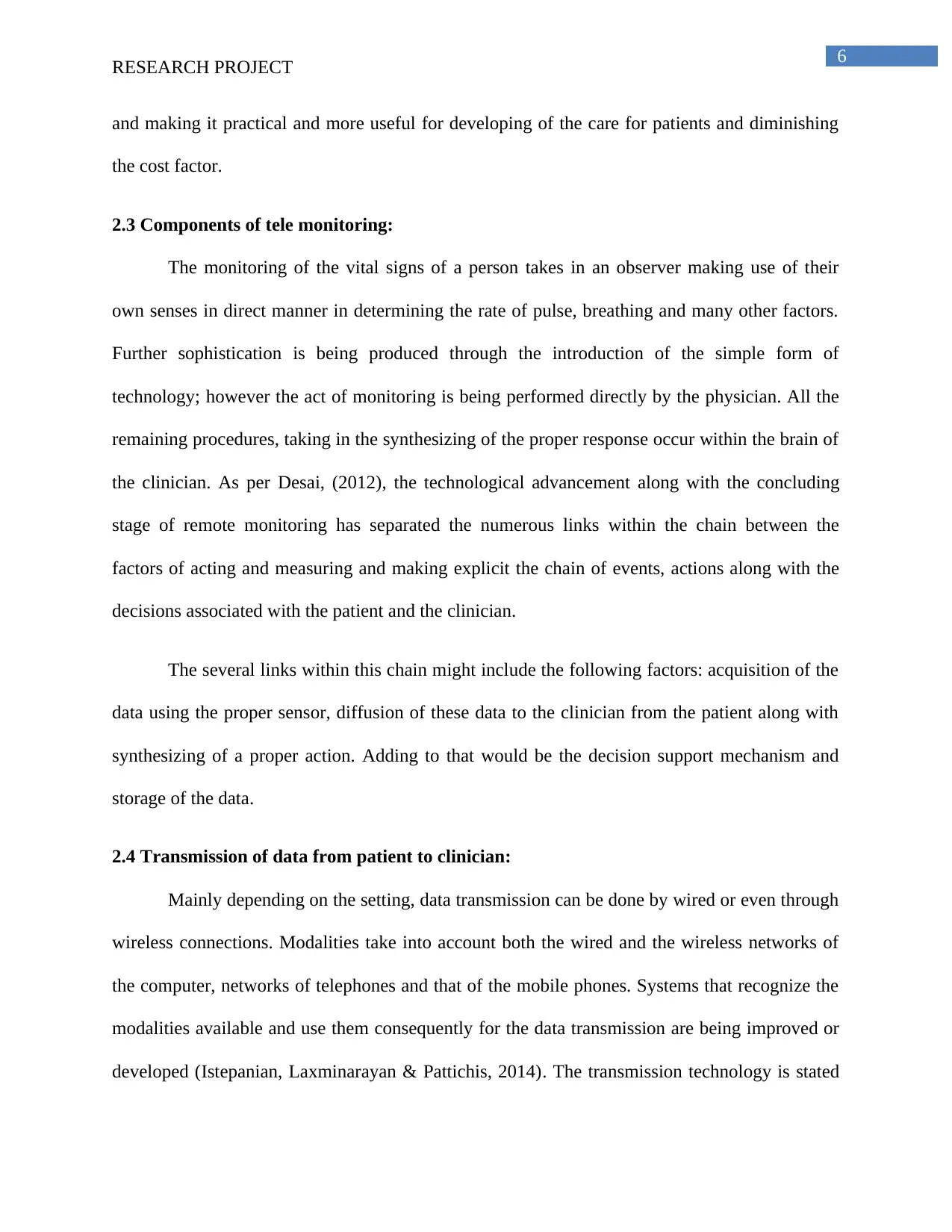
6
RESEARCH PROJECT
and making it practical and more useful for developing of the care for patients and diminishing
the cost factor.
2.3 Components of tele monitoring:
The monitoring of the vital signs of a person takes in an observer making use of their
own senses in direct manner in determining the rate of pulse, breathing and many other factors.
Further sophistication is being produced through the introduction of the simple form of
technology; however the act of monitoring is being performed directly by the physician. All the
remaining procedures, taking in the synthesizing of the proper response occur within the brain of
the clinician. As per Desai, (2012), the technological advancement along with the concluding
stage of remote monitoring has separated the numerous links within the chain between the
factors of acting and measuring and making explicit the chain of events, actions along with the
decisions associated with the patient and the clinician.
The several links within this chain might include the following factors: acquisition of the
data using the proper sensor, diffusion of these data to the clinician from the patient along with
synthesizing of a proper action. Adding to that would be the decision support mechanism and
storage of the data.
2.4 Transmission of data from patient to clinician:
Mainly depending on the setting, data transmission can be done by wired or even through
wireless connections. Modalities take into account both the wired and the wireless networks of
the computer, networks of telephones and that of the mobile phones. Systems that recognize the
modalities available and use them consequently for the data transmission are being improved or
developed (Istepanian, Laxminarayan & Pattichis, 2014). The transmission technology is stated
RESEARCH PROJECT
and making it practical and more useful for developing of the care for patients and diminishing
the cost factor.
2.3 Components of tele monitoring:
The monitoring of the vital signs of a person takes in an observer making use of their
own senses in direct manner in determining the rate of pulse, breathing and many other factors.
Further sophistication is being produced through the introduction of the simple form of
technology; however the act of monitoring is being performed directly by the physician. All the
remaining procedures, taking in the synthesizing of the proper response occur within the brain of
the clinician. As per Desai, (2012), the technological advancement along with the concluding
stage of remote monitoring has separated the numerous links within the chain between the
factors of acting and measuring and making explicit the chain of events, actions along with the
decisions associated with the patient and the clinician.
The several links within this chain might include the following factors: acquisition of the
data using the proper sensor, diffusion of these data to the clinician from the patient along with
synthesizing of a proper action. Adding to that would be the decision support mechanism and
storage of the data.
2.4 Transmission of data from patient to clinician:
Mainly depending on the setting, data transmission can be done by wired or even through
wireless connections. Modalities take into account both the wired and the wireless networks of
the computer, networks of telephones and that of the mobile phones. Systems that recognize the
modalities available and use them consequently for the data transmission are being improved or
developed (Istepanian, Laxminarayan & Pattichis, 2014). The transmission technology is stated
Paraphrase This Document
Need a fresh take? Get an instant paraphrase of this document with our AI Paraphraser

7
RESEARCH PROJECT
to be the indispensable glue in the several possible topological chains. Its abilities predicate the
effectiveness of some of the other components. Technological transmission will be required for
selection as per the particular use envisioned. The process of data transmission from the patient
party to the clinician might be a continuous process or might occur only when an exception of
pre-defined nature has taken place or at the time of availability of connection.
Under the present circumstances, various systems tend to use the standards of proprietary
for the process of data communication. Governments have started setting up of the aside
proportions of the spectrum of electromagnetic for the purpose of specific use of the wireless
telemetry, though not always consistent across the international regions with cropping up of the
issues related to interferences (Piyare, 2013).
2.5 Data Integration with state of patient:
This process may be conducted either with the help of a computer or a clinician, or it
might be both. Incorporation of computer along with the data analysis process and their
combination into the information on which the act is to take place can occur anywhere within the
chain. Adding to that is the fact it might be distributed across the process. Amongst many other
things, this is mainly dependent on the requirement of data that is being conveyed along the
chain that is itself dependent on the availability of the bandwidth and its cost. Raw data needs to
be transmitted or simple the rate of heart, a full set of the vital signs that could be conveyed likes
the warning score or other point of index of the severity of the patients on the factor of illness
(Suryadevara & Mukhopadhyay, 2012).
The uncovering of a meticulous patient state resulting from the incorporation of the
computer along with the evaluation of the data and their synthesis might be used in triggering the
RESEARCH PROJECT
to be the indispensable glue in the several possible topological chains. Its abilities predicate the
effectiveness of some of the other components. Technological transmission will be required for
selection as per the particular use envisioned. The process of data transmission from the patient
party to the clinician might be a continuous process or might occur only when an exception of
pre-defined nature has taken place or at the time of availability of connection.
Under the present circumstances, various systems tend to use the standards of proprietary
for the process of data communication. Governments have started setting up of the aside
proportions of the spectrum of electromagnetic for the purpose of specific use of the wireless
telemetry, though not always consistent across the international regions with cropping up of the
issues related to interferences (Piyare, 2013).
2.5 Data Integration with state of patient:
This process may be conducted either with the help of a computer or a clinician, or it
might be both. Incorporation of computer along with the data analysis process and their
combination into the information on which the act is to take place can occur anywhere within the
chain. Adding to that is the fact it might be distributed across the process. Amongst many other
things, this is mainly dependent on the requirement of data that is being conveyed along the
chain that is itself dependent on the availability of the bandwidth and its cost. Raw data needs to
be transmitted or simple the rate of heart, a full set of the vital signs that could be conveyed likes
the warning score or other point of index of the severity of the patients on the factor of illness
(Suryadevara & Mukhopadhyay, 2012).
The uncovering of a meticulous patient state resulting from the incorporation of the
computer along with the evaluation of the data and their synthesis might be used in triggering the

8
RESEARCH PROJECT
transmission of the data. These are mainly the engineering decisions inter-related to certain
particular application. Apart from just the physical service part of the system, this network also
makes patients feel mentally comforted knowing that are always being monitored and if any
problem arises, they will be given help as soon as possible.
2.6 The challenge:
The cost of delivering the healthcare is increasing with every passing day and managing
of the same is becoming an issue, especially in Australia. Targeting of the healthcare services in
assisting the ageing population along with the ones suffering from chronicle diseases accounted
for over 70 per cent of the $103.8 billion expenditure related to Australian healthcare during the
period of 2007-2008; can assist in reducing the load on the systems of health along with the
hospitals. ‘Frequent Flyers’ are stated to be high cost patients within the system of health, who
typically have an amalgamation of complicated medical conditions like the diseases of lungs,
cardiovascular disease or like diabetes along with visiting the hospital twice or thrice per year.
2.7 Response:
Funded by the Australian Government Tele-health Pilots Program along with CSIRO, the
formation of the e-health proficiency and partnered with the NGOs, local districts of health and
industry partners in delivering of a national level tele-health of home monitoring of the chronic
diseases for the aged people. A survey was conducted over a year in enabling the chronic disease
patients in self-managing their conditions within their homes through the stipulation of the
services related to tele-health (Ventola, 2014). Workers related to health could review changes in
the conditions of the patients tenuously and offering of proper care interventions prior in helping
them staying out of the hospital and developing their life quality.
RESEARCH PROJECT
transmission of the data. These are mainly the engineering decisions inter-related to certain
particular application. Apart from just the physical service part of the system, this network also
makes patients feel mentally comforted knowing that are always being monitored and if any
problem arises, they will be given help as soon as possible.
2.6 The challenge:
The cost of delivering the healthcare is increasing with every passing day and managing
of the same is becoming an issue, especially in Australia. Targeting of the healthcare services in
assisting the ageing population along with the ones suffering from chronicle diseases accounted
for over 70 per cent of the $103.8 billion expenditure related to Australian healthcare during the
period of 2007-2008; can assist in reducing the load on the systems of health along with the
hospitals. ‘Frequent Flyers’ are stated to be high cost patients within the system of health, who
typically have an amalgamation of complicated medical conditions like the diseases of lungs,
cardiovascular disease or like diabetes along with visiting the hospital twice or thrice per year.
2.7 Response:
Funded by the Australian Government Tele-health Pilots Program along with CSIRO, the
formation of the e-health proficiency and partnered with the NGOs, local districts of health and
industry partners in delivering of a national level tele-health of home monitoring of the chronic
diseases for the aged people. A survey was conducted over a year in enabling the chronic disease
patients in self-managing their conditions within their homes through the stipulation of the
services related to tele-health (Ventola, 2014). Workers related to health could review changes in
the conditions of the patients tenuously and offering of proper care interventions prior in helping
them staying out of the hospital and developing their life quality.
⊘ This is a preview!⊘
Do you want full access?
Subscribe today to unlock all pages.

Trusted by 1+ million students worldwide

9
RESEARCH PROJECT
2.8 Health Monitoring System using Internet of Things (IoT)
It is a global challenge to ensure timely healthcare access, in both rural as well as urban
areas. Every nation, every government tries to ensure the best possible healthcare facilities for its
citizens. It harnesses every resource in its knowledge to bring the maximum healthcare benefits
for the people (Hassanalieraghet al., 2015). Along with this, with the global advent of internet
and access to information from any place at any time, monitoring the healthcare system
constantly and using this technological tool is becoming increasingly important. This newly
developing aspect of healthcare providing services is altering all the previously held ideas about
the roles and responsibilities of each component and player of the service sector. Every input of
the sector is having itstasks and responsibilities redefined. This is altering the whole equation
and structure of the sector (Rahmaniet al., 2015). The continuous rise of the internet has rendered
almost every information relating to healthcare and diseases to be free and accessible by
everyone. This means that everyone can gather information by themselves without having to be
reliant upon the health care providers.
2.9 Remote Health Monitoring System and its role
The RHM is a systematic framework that enables health care providers to monitor and
treat a patient outside of the conventional settings of a clinic. However, this facility of being
accessible to the health care services at all the time may increase the costs of the same. But the
fact is, incurring the extra cost may ultimately make sure that a patient has a longer and healthier
life. Patients are given health services which is delivered to their own homes, which means that
the elderly people do not have to be reliant on anyone to avail the services(Islamet al., 2015).
In today’s world, where everything has to be on time and every task has to be perfectly
RESEARCH PROJECT
2.8 Health Monitoring System using Internet of Things (IoT)
It is a global challenge to ensure timely healthcare access, in both rural as well as urban
areas. Every nation, every government tries to ensure the best possible healthcare facilities for its
citizens. It harnesses every resource in its knowledge to bring the maximum healthcare benefits
for the people (Hassanalieraghet al., 2015). Along with this, with the global advent of internet
and access to information from any place at any time, monitoring the healthcare system
constantly and using this technological tool is becoming increasingly important. This newly
developing aspect of healthcare providing services is altering all the previously held ideas about
the roles and responsibilities of each component and player of the service sector. Every input of
the sector is having itstasks and responsibilities redefined. This is altering the whole equation
and structure of the sector (Rahmaniet al., 2015). The continuous rise of the internet has rendered
almost every information relating to healthcare and diseases to be free and accessible by
everyone. This means that everyone can gather information by themselves without having to be
reliant upon the health care providers.
2.9 Remote Health Monitoring System and its role
The RHM is a systematic framework that enables health care providers to monitor and
treat a patient outside of the conventional settings of a clinic. However, this facility of being
accessible to the health care services at all the time may increase the costs of the same. But the
fact is, incurring the extra cost may ultimately make sure that a patient has a longer and healthier
life. Patients are given health services which is delivered to their own homes, which means that
the elderly people do not have to be reliant on anyone to avail the services(Islamet al., 2015).
In today’s world, where everything has to be on time and every task has to be perfectly
Paraphrase This Document
Need a fresh take? Get an instant paraphrase of this document with our AI Paraphraser
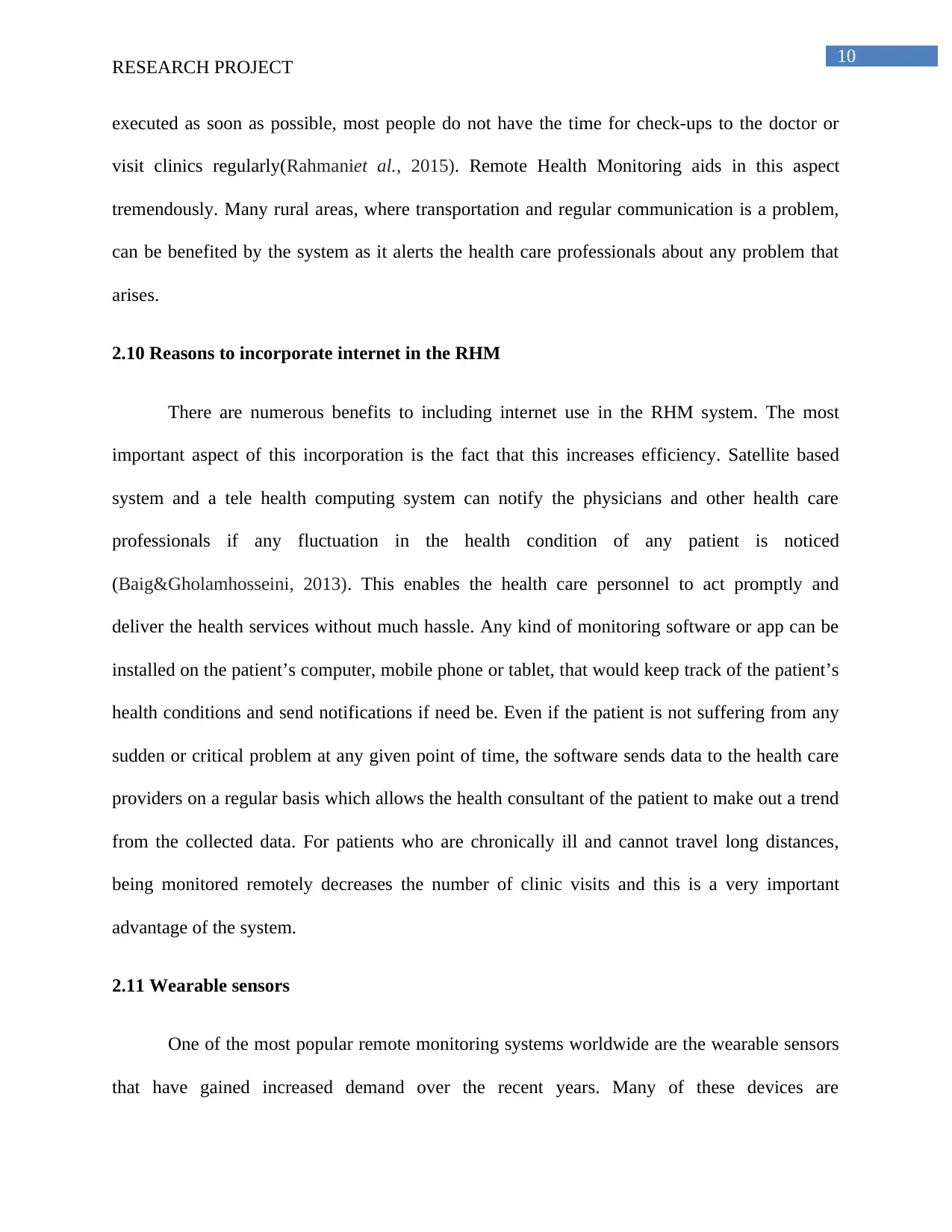
10
RESEARCH PROJECT
executed as soon as possible, most people do not have the time for check-ups to the doctor or
visit clinics regularly(Rahmaniet al., 2015). Remote Health Monitoring aids in this aspect
tremendously. Many rural areas, where transportation and regular communication is a problem,
can be benefited by the system as it alerts the health care professionals about any problem that
arises.
2.10 Reasons to incorporate internet in the RHM
There are numerous benefits to including internet use in the RHM system. The most
important aspect of this incorporation is the fact that this increases efficiency. Satellite based
system and a tele health computing system can notify the physicians and other health care
professionals if any fluctuation in the health condition of any patient is noticed
(Baig&Gholamhosseini, 2013). This enables the health care personnel to act promptly and
deliver the health services without much hassle. Any kind of monitoring software or app can be
installed on the patient’s computer, mobile phone or tablet, that would keep track of the patient’s
health conditions and send notifications if need be. Even if the patient is not suffering from any
sudden or critical problem at any given point of time, the software sends data to the health care
providers on a regular basis which allows the health consultant of the patient to make out a trend
from the collected data. For patients who are chronically ill and cannot travel long distances,
being monitored remotely decreases the number of clinic visits and this is a very important
advantage of the system.
2.11 Wearable sensors
One of the most popular remote monitoring systems worldwide are the wearable sensors
that have gained increased demand over the recent years. Many of these devices are
RESEARCH PROJECT
executed as soon as possible, most people do not have the time for check-ups to the doctor or
visit clinics regularly(Rahmaniet al., 2015). Remote Health Monitoring aids in this aspect
tremendously. Many rural areas, where transportation and regular communication is a problem,
can be benefited by the system as it alerts the health care professionals about any problem that
arises.
2.10 Reasons to incorporate internet in the RHM
There are numerous benefits to including internet use in the RHM system. The most
important aspect of this incorporation is the fact that this increases efficiency. Satellite based
system and a tele health computing system can notify the physicians and other health care
professionals if any fluctuation in the health condition of any patient is noticed
(Baig&Gholamhosseini, 2013). This enables the health care personnel to act promptly and
deliver the health services without much hassle. Any kind of monitoring software or app can be
installed on the patient’s computer, mobile phone or tablet, that would keep track of the patient’s
health conditions and send notifications if need be. Even if the patient is not suffering from any
sudden or critical problem at any given point of time, the software sends data to the health care
providers on a regular basis which allows the health consultant of the patient to make out a trend
from the collected data. For patients who are chronically ill and cannot travel long distances,
being monitored remotely decreases the number of clinic visits and this is a very important
advantage of the system.
2.11 Wearable sensors
One of the most popular remote monitoring systems worldwide are the wearable sensors
that have gained increased demand over the recent years. Many of these devices are
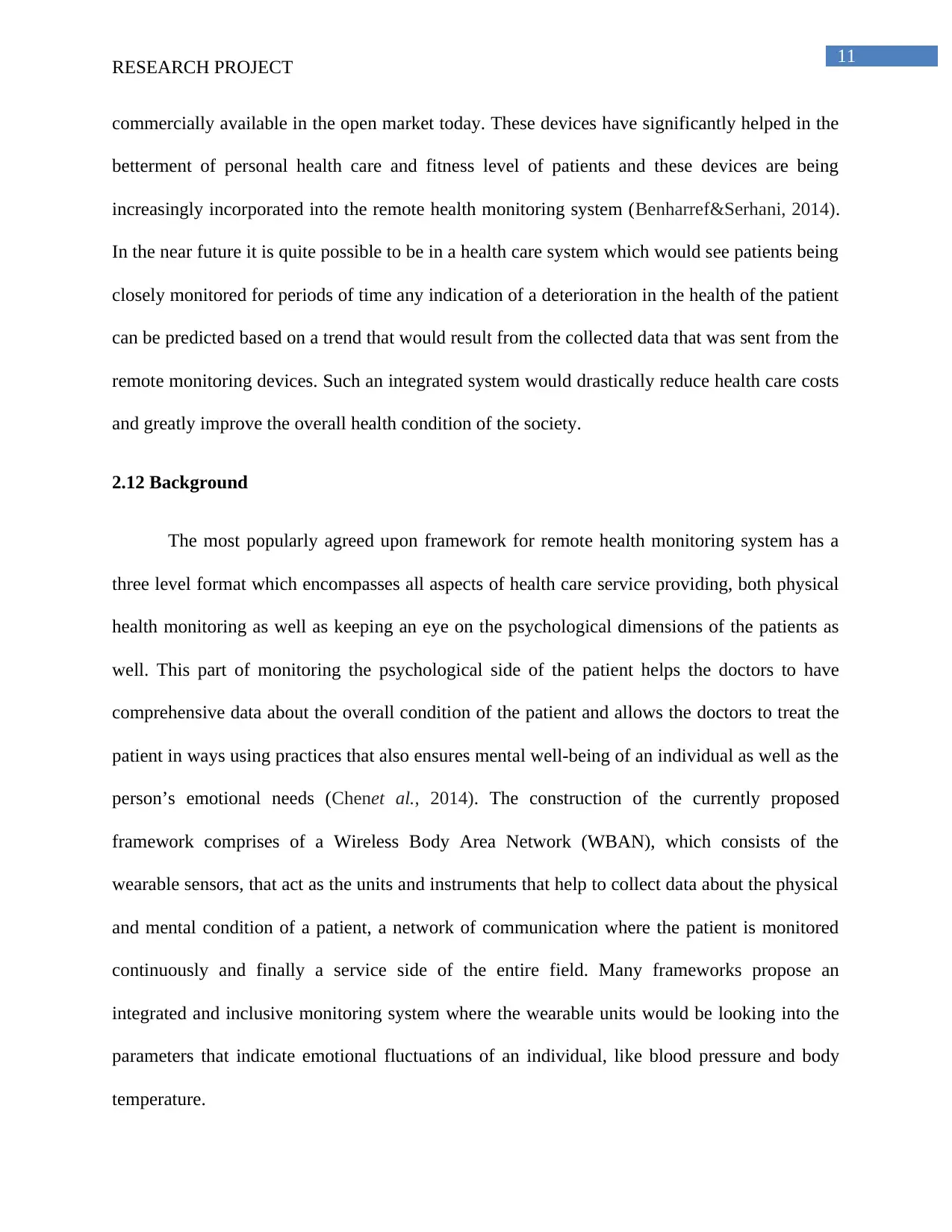
11
RESEARCH PROJECT
commercially available in the open market today. These devices have significantly helped in the
betterment of personal health care and fitness level of patients and these devices are being
increasingly incorporated into the remote health monitoring system (Benharref&Serhani, 2014).
In the near future it is quite possible to be in a health care system which would see patients being
closely monitored for periods of time any indication of a deterioration in the health of the patient
can be predicted based on a trend that would result from the collected data that was sent from the
remote monitoring devices. Such an integrated system would drastically reduce health care costs
and greatly improve the overall health condition of the society.
2.12 Background
The most popularly agreed upon framework for remote health monitoring system has a
three level format which encompasses all aspects of health care service providing, both physical
health monitoring as well as keeping an eye on the psychological dimensions of the patients as
well. This part of monitoring the psychological side of the patient helps the doctors to have
comprehensive data about the overall condition of the patient and allows the doctors to treat the
patient in ways using practices that also ensures mental well-being of an individual as well as the
person’s emotional needs (Chenet al., 2014). The construction of the currently proposed
framework comprises of a Wireless Body Area Network (WBAN), which consists of the
wearable sensors, that act as the units and instruments that help to collect data about the physical
and mental condition of a patient, a network of communication where the patient is monitored
continuously and finally a service side of the entire field. Many frameworks propose an
integrated and inclusive monitoring system where the wearable units would be looking into the
parameters that indicate emotional fluctuations of an individual, like blood pressure and body
temperature.
RESEARCH PROJECT
commercially available in the open market today. These devices have significantly helped in the
betterment of personal health care and fitness level of patients and these devices are being
increasingly incorporated into the remote health monitoring system (Benharref&Serhani, 2014).
In the near future it is quite possible to be in a health care system which would see patients being
closely monitored for periods of time any indication of a deterioration in the health of the patient
can be predicted based on a trend that would result from the collected data that was sent from the
remote monitoring devices. Such an integrated system would drastically reduce health care costs
and greatly improve the overall health condition of the society.
2.12 Background
The most popularly agreed upon framework for remote health monitoring system has a
three level format which encompasses all aspects of health care service providing, both physical
health monitoring as well as keeping an eye on the psychological dimensions of the patients as
well. This part of monitoring the psychological side of the patient helps the doctors to have
comprehensive data about the overall condition of the patient and allows the doctors to treat the
patient in ways using practices that also ensures mental well-being of an individual as well as the
person’s emotional needs (Chenet al., 2014). The construction of the currently proposed
framework comprises of a Wireless Body Area Network (WBAN), which consists of the
wearable sensors, that act as the units and instruments that help to collect data about the physical
and mental condition of a patient, a network of communication where the patient is monitored
continuously and finally a service side of the entire field. Many frameworks propose an
integrated and inclusive monitoring system where the wearable units would be looking into the
parameters that indicate emotional fluctuations of an individual, like blood pressure and body
temperature.
⊘ This is a preview!⊘
Do you want full access?
Subscribe today to unlock all pages.

Trusted by 1+ million students worldwide
1 out of 35
Related Documents
Your All-in-One AI-Powered Toolkit for Academic Success.
+13062052269
info@desklib.com
Available 24*7 on WhatsApp / Email
![[object Object]](/_next/static/media/star-bottom.7253800d.svg)
Unlock your academic potential
Copyright © 2020–2025 A2Z Services. All Rights Reserved. Developed and managed by ZUCOL.




